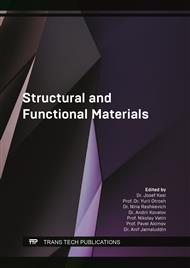[1]
Kim, D.V., Cong, L.N., Van, L.T., Bazhenova, S.I.: Foamed concrete containing various amounts of organic- mineral additives. Journal of Physics: Conference Series 1425, 1-12 (2020).
DOI: 10.1088/1742-6596/1425/1/012199
Google Scholar
[2]
Fomina, E.V., Strokova, V.V., Kozhukhova, N.I.: Application of natural aluminosilicates in autoclave cellular concrete. World Applied Sciences Journal 25(1) 48–54 (2013).
Google Scholar
[3]
Chica, L., Alzate, A.: Cellular concrete review: new trends for application in construction. Construction and Building Materials 200, 637–647 (2019).
DOI: 10.1016/j.conbuildmat.2018.12.136
Google Scholar
[4]
Besbes, E., Jury, V., Monteau, J.Y., Le Bail, A.: Characterizing the cellular structure of bread crumb and crust as affected by heating rate using X-ray microtomography. Journal of Food Engineering 115(3) 415–423 (2013).
DOI: 10.1016/j.jfoodeng.2012.10.005
Google Scholar
[5]
Anatol'yevich, B.V.: Aerated concrete for monolithic enclosing structures with a variatropic burrow structure 145 (2003).
Google Scholar
[6]
Konstantinovna, K.L. Formation of a cellular structure and technology of foams from zeolite-containing raw materials 262 (2002).
Google Scholar
[7]
Zhang, S., Cao, K., Wang, C., Wang, X., Wang, J., Sun, B.: Effect of silica fume and waste marble powder on the mechanical and durability properties of cellular concrete. Construction and Building Materials 241, 1-17 (2020).
DOI: 10.1016/j.conbuildmat.2019.117980
Google Scholar
[8]
Anvar, A., Shaumarov, S., Elena, S., Ulugbek, S.: New method for diagnostic of heat engineering and mechanical properties of cellular concrete. International Journal of Engineering and Advanced Technology 9(1), 6885–6887 (2019).
Google Scholar
[9]
Bruyako M.G., Ushkov V.A., Torosyan D.V., Grigor'yeva A.I., Volov A.D., Yergenyan A.M., Tvorogova Y.A.: Method of manufacturing variatropic aerated concrete (2017).
Google Scholar
[10]
Korolev A.S., Voloshin Ye.A., Trofimov B.YA., Shaimov M.KH., K.S.A.: Method of manufacturing variatropic aerated concrete products (2004).
Google Scholar
[11]
Anatol'yevich, B.V.: Aerated concrete for monolithic enclosing structures with a variatropic pore structure 145 (2003).
Google Scholar
[12]
Korotyshevskiy O.V., Shkuridin V.G.: A method of preparing a porous building mixture and a device for its implementation (options) (1997).
Google Scholar
[13]
Sahu, S.S., Gandhi, I.S.R., Khwairakpam, S.: State-of-the-Art Review on the Characteristics of Surfactants and Foam from Foam Concrete Perspective. Journal of The Institution of Engineers (India): Series A 99(2), 391–405 (2018).
DOI: 10.1007/s40030-018-0288-5
Google Scholar
[14]
Narayanan, N., Ramamurthy, K.: Structure and properties of aerated concrete: A review. Cement and Concrete Composites 22(5), 321–329 (2000).
DOI: 10.1016/s0958-9465(00)00016-0
Google Scholar
[15]
Ramamurthy, K., Kunhanandan Nambiar, E.K., Indu Siva Ranjani, G.: A classification of studies on properties of foam concrete. Cement and Concrete Composites 31(6), 388–396 (2009).
DOI: 10.1016/j.cemconcomp.2009.04.006
Google Scholar
[16]
Amran, Y.H.M., Farzadnia, N., Ali, A.A.A.: Properties and applications of foamed concrete; A review 101, 990-1005 (2015).
DOI: 10.1016/j.conbuildmat.2015.10.112
Google Scholar
[17]
Schreiner, J., Jansen, D., Ectors, D., Goetz-Neunhoeffer, F., Neubauer, J., Volkmann, S.: New analytical possibilities for monitoring the phase development during the production of autoclaved aerated concrete. Cement and Concrete Research 107, 247–252 (2018).
DOI: 10.1016/j.cemconres.2018.02.028
Google Scholar
[18]
Dmitriyevich, S.V.: Structure and properties of nanomodified cement stone 177 (2008).
Google Scholar
[19]
Vu, K.D., Bazhenova, S.I.: Modeling the influence of input factors on foam concrete properties. Magazine of Civil Engineering 103(3), 1-10 (2021).
Google Scholar


